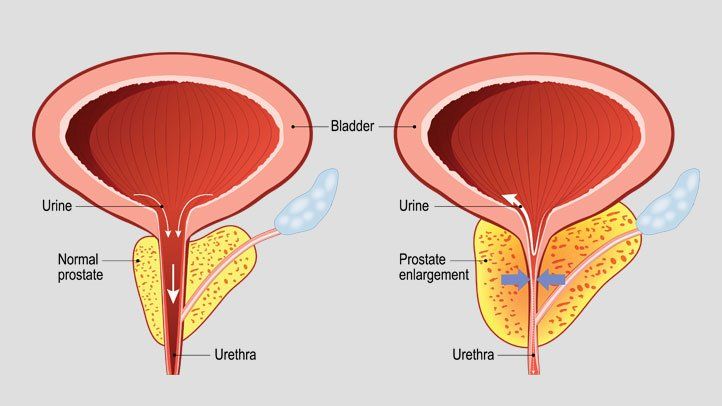
Enlargement of the prostate is called benign prostatic hyperplasia (BPH). It occurs when the cells of the prostate gland begin to multiply. These additional cells cause your prostate gland to swell, which squeezes the urethra and limits the flow of urine.
BPH isn’t the same as prostate cancer and doesn’t increase your risk for cancer. However, it can cause symptoms that can affect your quality of life.
BPH is common in men over 50.
BPH is considered a normal condition of aging. Although the exact cause is unknown, changes in male sex hormones that come with aging may be a factor.
Any family history of prostate problems or any abnormalities with your testicles may raise your risk for BPH. Men who’ve had their testicles removed at a young age don’t develop BPH.
The symptoms of BPH are often very mild at first, but they become more serious if they aren’t treated. Common symptoms include:
Talk with your doctor if you have any of these symptoms. They’re treatable, and treating them often can help prevent complications.
When checking you for BPH, your doctor will usually begin by doing a physical exam and asking you about your medical history. The physical exam includes a rectal examination that allows the doctor to estimate the size and shape of your prostate. Other tests can include:
Your doctor may also ask about medications you’re taking that might be affecting your urinary system, such as:
Your doctor can make any necessary medication adjustments. Don’t attempt to adjust your medications or doses yourself.
Let your doctor know if you’ve taken self-care measures for your symptoms for at least 2 months without noticing any improvement.
0 seconds of 5 secondsVolume 0%
Treatment of BPH can begin with self-care and lifestyle adjustments. If symptoms don’t subside, medication or surgery may be recommended. Your age and general health will also influence the prescribed treatment.
Learn more about BPH treatment.
BPH natural treatment
Natural treatment can include specific actions or lifestyle changes that you can make to help relieve your symptoms of BPH. These include:
Some people also include natural remedies in their treatment of BPH. However, there isn’t evidence that they’re effective.
Learn more about BPH natural remedies.
When lifestyle changes aren’t enough to relieve your symptoms, your doctor may recommend medication.
There are several medications that can help to both treat the symptoms of BPH and BPH itself. These medications include:
Learn more about BPH medications.
Alpha-1 blockers are medications that relax the muscles of the bladder and prostate. Alpha-1 blockers relax the neck of the bladder and make it easier for urine to flow. Examples of alpha-1 blockers include:
Medications that reduce the levels of hormones produced by the prostate gland, such as dutasteride and finasteride, are commonly prescribed.
These two medications lower the levels of dihydrotestosterone (DHT), a more potent variation of testosterone that affects hair and prostate growth, among other functions.
Sometimes, lowering the hormone levels will make the prostate get smaller and improve urine flow. However, in rare cases, these medications may also lead to side effects such as impotence and a decreased sex drive.
Antibiotics may be used if your prostate becomes chronically inflamed from bacterial prostatitis related to BPH.
Treating bacterial prostatitis with antibiotics may improve your symptoms of BPH by reducing the inflammation. However, antibiotics won’t help prostatitis or inflammation that is not caused by bacteria.
Surgery for BPH
There are different types of surgical procedures that can help treat BPH when medications aren’t effective. Some procedures are either noninvasive or minimally invasive and can often be done in your doctor’s office or clinic (outpatient procedures).
Others are more invasive and need to be done in a hospital (inpatient procedures).
Outpatient procedures involve inserting an instrument into your urethra and into the prostate gland. They include:
Urolift and Rezūm have both been shownTrusted Source to be nearly as effective as inpatient surgical treatments like TURP, with the added benefits of being less invasive, less costly, and more likely to preserve sexual functionality.
Inpatient procedures might be recommended if you have any of the following symptoms:
Inpatient procedures include:
Complications of BPH
The symptoms of BPH can be easy to ignore. However, early treatment can help you avoid potentially dangerous complications. Call your doctor if you’re noticing symptoms of BPH.
People with a long-standing history of BPH may develop the following complications:
Sometimes, urinary obstruction from BPH is so severe that no urine can leave the bladder at all. This is called bladder outlet obstruction. It can be dangerous because urine trapped in the bladder can cause urinary tract infections and damage your kidneys.